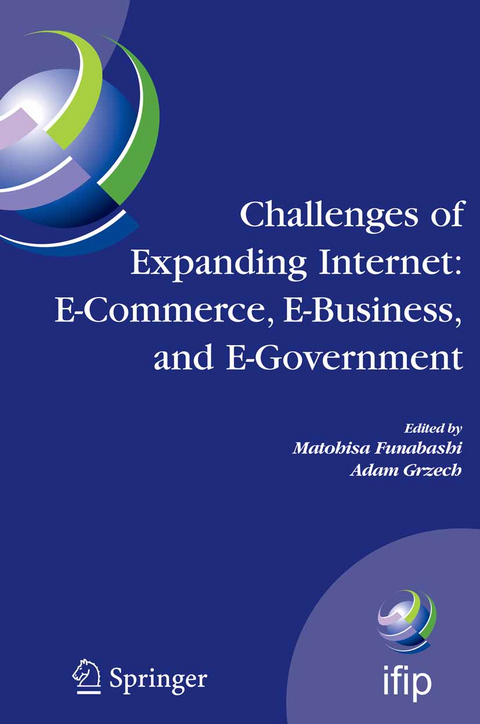
Challenges of Expanding Internet: E-Commerce, E-Business, and E-Government
Springer-Verlag New York Inc.
978-1-4419-3952-4 (ISBN)
Innovative Business Models.- Value Process and Business Process in E-Business Modelling.- VA3: Governance Selection in Value Webs.- From an E-Business Revenue Model to Its Software Reference Architecture.- e-Collaboration and e-Services.- Selecting Supply Partners for E-Collaboration in Supply Chains.- E-Collaboration Architecture for Customer-Driven Business Processes in Inter-Organizational Scenarios.- Monitoring Middleware for Service Level Agreements in Heterogeneous Environments.- G2G, G2B, and G2C Models.- Using Software Agents to Personalize Access to E-Offices.- Evaluating E-Government.- A Knowledge-Sharing Framework for Public Administrations.- One-Stop Government — Service Integration.- Configuring E-Government Services Using Ontologies.- A Business Rule Engine Applied to Egovernment Services Integration.- Towards Dynamic Composition of E-Government Services.- e-Government - Trust and Security.- Employing Ontologies for the Development of Security Critical Applications.- Development and Evaluation of a System for Checking for Improper Sending of Personal Information in Encrypted E-Mail.- Hypr&A - A Security Model for the Support Processes in Egovernment.- e-Health and e-Democracy.- Policy-Rich Multi-Agent Support for E-Health Applications.- Pursuing Electronic Health.- E-Petitioning: Enabling Ground-Up Participation.- Architecture of Multi Channel Multi Database Voting System.- Public e-Services for Citizens and Enterprises.- Practitioner Buy-in and Resistance to E-Enabled Information Sharing Across Agencies.- Legalurn: A Framework for Organizing and Surfing Legal Documents on the Web.- A Web Service Approach to Geographical Data Distribution Among Public Administrations.- Digital Goods and Products.- Second generation micropayment systems: lessons learned.-Value Analysis of Retail Electronic Payments Market.- Personalized Discount - A Fuzzy Logic Approach.- B2B, B2C, and C2C Models.- Dynamic Model Harmonization Between Unknown eBusiness Systems.- Active Advertisement in Supermarkets Using Personal Agents.- A Smart HTTP Communicator: SMACH.- e-Marketplaces, e-Hubs, and Portals.- Mobile Portal Implementation Strategy: A Theoretical Exploration.- Cross-Organizational Workflows: A Classification of Design Decisions.- Biovault: Solving the Problem of Replay in Biometrics.- Computing for e-Commerce.- Integration of XML Data in Peer-to-Peer E-Commerce Applications.- Using ebXML for Supply Chain Traceability.- An XML-Based Data Model for Vulnerability Assessment Reports.- User Behavior Modeling.- Admission Control for the Customers over the Vendor’s VPN.- Role of the Customer Value in the Software as a Service Concept.- Robalo: A Risk-Oriented Job Dispatching Mechanism for Workforce Management System.- Pervasive Technologies for e-Commerce.- Discovery and Query: Two Semantic Processes for Web Services.- Dyng: A Multi-Protocol Collaborative System.- Development Concept for and Trial Application of a “Mulutiplex Risk Communicator”.
| Erscheint lt. Verlag | 8.12.2010 |
|---|---|
| Reihe/Serie | IFIP International Federation for Information Processing ; 189 |
| Zusatzinfo | XXIV, 627 p. |
| Verlagsort | New York, NY |
| Sprache | englisch |
| Maße | 155 x 235 mm |
| Themenwelt | Mathematik / Informatik ► Informatik ► Datenbanken |
| Mathematik / Informatik ► Informatik ► Netzwerke | |
| Informatik ► Office Programme ► Outlook | |
| Informatik ► Theorie / Studium ► Kryptologie | |
| Informatik ► Weitere Themen ► Hardware | |
| Wirtschaft ► Allgemeines / Lexika | |
| Wirtschaft ► Betriebswirtschaft / Management ► Marketing / Vertrieb | |
| ISBN-10 | 1-4419-3952-0 / 1441939520 |
| ISBN-13 | 978-1-4419-3952-4 / 9781441939524 |
| Zustand | Neuware |
| Haben Sie eine Frage zum Produkt? |
aus dem Bereich


